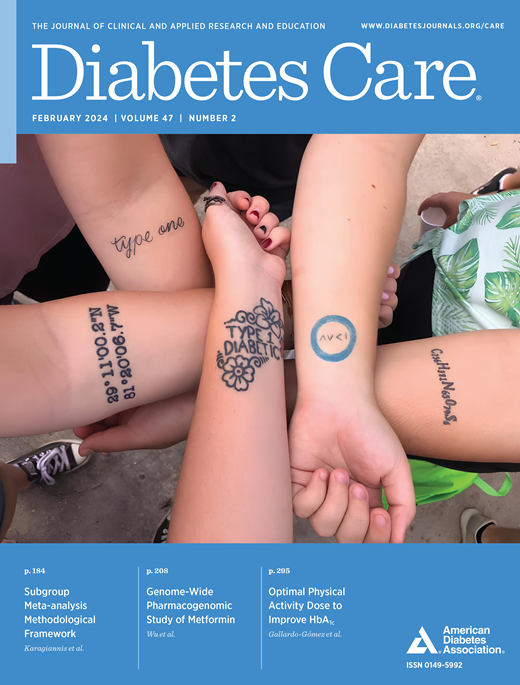生活在得克萨斯州斯塔县的墨西哥裔美国人的加速纵向血糖变化与尿液中有毒/基本金属和金属混合物的关系
IF 16.6
1区 医学
Q1 ENDOCRINOLOGY & METABOLISM
引用次数: 0
摘要
目的 金属和类金属暴露(以下简称 "金属")与包括 2 型糖尿病在内的不良健康后果有关;然而,以往的研究大多是横断面研究,或者研究力量不足。此外,尽管 2 型糖尿病的发病率较高,接触金属的风险也较大,但在环境健康研究中,未得到充分服务的种族/民族群体的代表性不足。因此,我们在墨西哥裔美国成年人队列中评估了连续血糖特征与基线尿液中有毒金属、基本金属和金属混合物的关系。研究设计与方法 根据自我报告的糖尿病状况,共挑选了 510 名参与者,并对其进行了为期 3 年的跟踪调查。在基线时对尿液中的金属进行评估。采用线性混合效应模型估算血红蛋白 A1c、空腹血浆葡萄糖和负荷后血糖的每月变化与尿液金属水平的关系。采用多种统计方法评估血糖特征与金属混合物之间的关联。结果 经调整后发现,尿液中砷、硒、铜、钼、镍和锡的含量越高,血糖测量值上升越快。由砷、铅、镉、镍和锡组成的有毒金属混合物与负荷后血糖的快速升高有关。根据负荷后血糖标准,最高砷含量与最低砷含量相比,预计正常血糖转化为糖尿病前期和糖尿病的时间分别加快了 23 个月和 65 个月。结论 在这一代表性不足的高风险墨西哥裔美国人群体中,暴露于有毒金属和基本金属稳态的改变与血糖随时间的加速增长有关,这可能会加速 2 型糖尿病的发展。本文章由计算机程序翻译,如有差异,请以英文原文为准。
Accelerated Longitudinal Glycemic Changes in Relation to Urinary Toxic/Essential Metals and Metal Mixtures Among Mexican Americans Living in Starr County, Texas
OBJECTIVE Metal and metalloid exposures (hereafter "metals") are associated with adverse health outcomes, including type 2 diabetes; however, previous studies were largely cross- sectional or underpowered. Furthermore, underserved racial/ethnic groups are underrepresented in environmental health research despite having higher rates of type 2 diabetes and a greater risk of metal exposures. Consequently, we evaluated continuous glycemic traits in relation to baseline urinary toxic metal, essential metal, and metal mixtures in a cohort of Mexican American adults. RESEARCH DESIGN AND METHODS A total of 510 participants were selected based upon self-reported diabetes status and followed over 3 years. Urinary metals were assessed at baseline. Linear mixed-effects models were used to estimate per-month changes in hemoglobin A1c, fasting plasma glucose, and postload glucose in relation to urinary metal levels. Multiple statistical approaches were used to assess the associations between glycemic traits and metal mixtures. RESULTS After adjustment, higher urinary levels of arsenic, selenium, copper, molybdenum, nickel, and tin were associated with faster increases in measures of glycemia. The toxic metal mixture composed of arsenic, lead, cadmium, nickel, and tin was associated with faster increases in postload glucose. Using postload glucose criteria, highest versus lowest arsenic was predicted to accelerate conversion of normoglycemia to prediabetes and diabetes by 23 and 65 months, respectively. CONCLUSIONS In this underrepresented, high-risk Mexican American population, exposure to toxic metals and alterations in essential metal homeostasis were associated with faster increases in glycemia over time that may accelerate type 2 diabetes development.
求助全文
通过发布文献求助,成功后即可免费获取论文全文。
去求助
来源期刊

Diabetes Care
医学-内分泌学与代谢
CiteScore
27.80
自引率
4.90%
发文量
449
审稿时长
1 months
期刊介绍:
The journal's overarching mission can be captured by the simple word "Care," reflecting its commitment to enhancing patient well-being. Diabetes Care aims to support better patient care by addressing the comprehensive needs of healthcare professionals dedicated to managing diabetes.
Diabetes Care serves as a valuable resource for healthcare practitioners, aiming to advance knowledge, foster research, and improve diabetes management. The journal publishes original research across various categories, including Clinical Care, Education, Nutrition, Psychosocial Research, Epidemiology, Health Services Research, Emerging Treatments and Technologies, Pathophysiology, Complications, and Cardiovascular and Metabolic Risk. Additionally, Diabetes Care features ADA statements, consensus reports, review articles, letters to the editor, and health/medical news, appealing to a diverse audience of physicians, researchers, psychologists, educators, and other healthcare professionals.
 求助内容:
求助内容: 应助结果提醒方式:
应助结果提醒方式:


